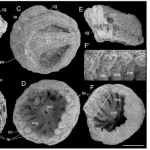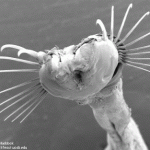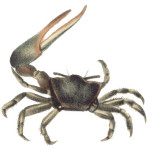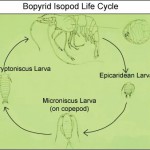![]() Finding any new fossil is rare. Finding invertebrate fossils is made even more rare because of the squishy nature of most invertebrates. Sometimes the wandering paleontologist, toiling away with utmost care through dust and debris, can find parts of squishy invertebrates like scolodonts (polychaete jaws), coral rubble, carbonate shell cement, or maybe sea star or sponge spicules. On even rarer conditions, this careful wandering paleontologist may find imprints of the outlines of squishy invertebrates that have no hard parts, none whatsoever.
Finding any new fossil is rare. Finding invertebrate fossils is made even more rare because of the squishy nature of most invertebrates. Sometimes the wandering paleontologist, toiling away with utmost care through dust and debris, can find parts of squishy invertebrates like scolodonts (polychaete jaws), coral rubble, carbonate shell cement, or maybe sea star or sponge spicules. On even rarer conditions, this careful wandering paleontologist may find imprints of the outlines of squishy invertebrates that have no hard parts, none whatsoever.
In recent decades, China has proven an amazing hot spot for important, gap-filling fossils. Entire ecosystems are preserved. Careful, wandering paleontologists are able to move beyond describing the random individual fossil to describing dinosaurs nests, embryonic fossils still in the egg, biometric trends in populations of fossil fish and molluscs, species interactions and just about anything else. The Chinese paleontologists have been prolific, publishing widely on their discoveries, inviting western paleontologists on digs and getting the Chinese people and government excited about their fossil wealth.

Zhang and colleagues present a new crustacean find with some interesting morphology and even more interesting implications. Yicaris dianensis is a new species named for both the people – the Yi – and the place the fossils originated from, Dian. (The suffix ‘caris’ refers to something that is a crustacean and the suffix ‘ensis’ refers to being from a place.) What is remarkable is about this discovery is that six successional developmental stages are represented in Precambrian strata, close to the hypothesized origin of the Crustacea.
“With such ontogeny data and having the age of the fossil as a time marker, it is possible to more precisely include ontogenetic evolutionary pathways in the reconstruction of relationships and ground patterns of stem species and monophyla. According to our analysis, Y. dianensis represents the first undoubted eucrustacean* known from the Lower Cambrian (the single previously described Lower Cambrian putative eucrustacean species lacks eucrustacean characters) and can serve as a substantial tool for testing relevant character acquisition and phylogenetic hypotheses. This is of particular importance because crustacean phylogeny has gained new interest by recent studies using neurobiological, developmental, biological and molecular investigations.”
* eu means true, so eucrustacea means the true crustaceans
Yicaris dianensis shares many features in common with modern day branchiopods and cephalocarids. Some of the similarities are in the mouthparts and other structures involved in feeding. The interesting character for this crustacean is called the epipod, literally “upon the foot”, which are lobe-shaped osmoregulatory or respiratory outgrowths on the external limb bases of various Eucrustaceans (SEM below). This structure is derived from setae and many of the Eucrustacea still bear at least one epipod on some of its appendages. Some authors even believe insect wings are derived from epipods (here and here).
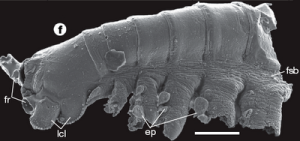
Yicaris was found in the Orsten layer, which is rich in Phosphatocopina, the sister group to Eucrustacea characterized by a phosphotatized cuticle. By using Lyell’s Principle of Uniformitarianism, one can assume that since the characters represented in Y. dianensis are present in the Lower Cambrian, its ancestors possessed some or all of its characters. As stated by Zhang and colleagues, arthropod origins are likely Precambrian.
Zhang, X., Siveter, D., Waloszek, D., & Maas, A. (2007). An epipodite-bearing crown-group crustacean from the Lower Cambrian Nature, 449 (7162), 595-598 DOI: 10.1038/nature06138

